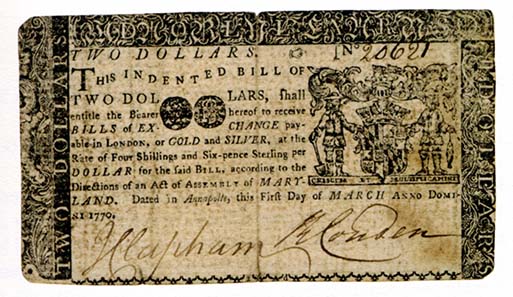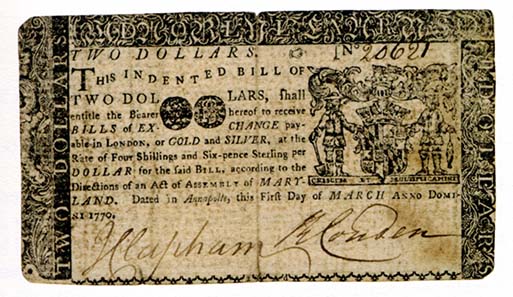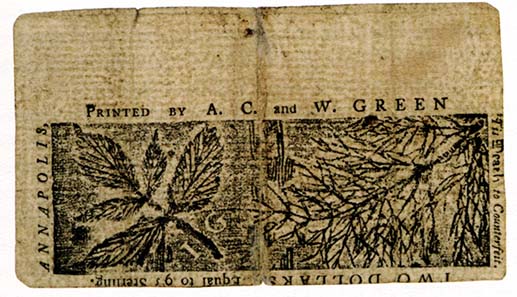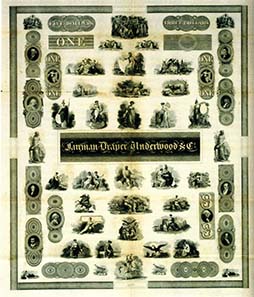November 22nd, 2011 – The Princeton University has organized an exhibit on Paper Money, which still can be seen to January 2, 2011.
Paper Money as a form of art might seem the makings of a rather small exhibition, to judge from the modern bills of the United States and Europe. Bank notes, however, have constituted one of the dominant forms of visual communication for the past two centuries, and in many cases can be seen as works of art in their own right. Princeton University’s Numismatic Collection is featuring currency worth looking at in the exhibition “Money on Paper: Bank Notes and Related Graphic Arts from the Collections of Vsevolod Onyshkevych and Princeton University,” on view in the Leonard L. Milberg Gallery for the Graphic Arts, Firestone Library, Princeton University, August 30, 2010, through January 2, 2011.
Maryland, 2 dollars, March 1, 1770. Printed by Ann Catherine Green and William Green. Photo: Money on Paper (2010).
Because British colonial policies resulted in a dearth of circulating coins, the American colonies were the home of the earliest regular issues of paper money. Illustration was appied to colonial currency as an anti-counterfeiting device as well as for aesthetic purposes. Not surprisingly, the most inventive printer of paper money of the time was Benjamin Franklin, who devised a system of transferring the vein patterns of tree leaves to printing plates to foil counterfeiters. The Princeton exhibition includes a large selection of Franklin’s nature-print notes, as well as issues of Paul Revere and the South Carolina engraver Thomas Coram, who brought classical imagery to that colony’s bank notes.
Sample sheet issued by the firm of Fairman, Draper, Underwood & Co., showing Audubon’s running grouse vignette at bottom left and right, 1830. Collection of Mark Tomasko. Photo: Money on Paper (2010).
One of the highlights of the exhibit is the first public display of the recently discovered banknote engraving of a grouse by John James Audubon, the great wildlife illustrator’s first published work. On display with a sample sheet containing the vignette will be an original watercolor by Audubon, a steel printing plate from “The Birds of America”, and the Princeton first edition of the elephant folio book open to the page with Audubon’s drawing of the pinnated grouse.
Asher B. Durand, one of America’s greatest painters, was also a major figure in the development of bank note art in this country. Along with his brother Cyrus, who invented a highly decorative series of anti-counterfeiting devices, he developed a classical, patriotic approach to bank note design that dominated the medium for the first half of the nineteenth century.
A section of the Princeton exhibit explores the divergence of imagery on the bank notes of northern and southern issuers before and during the Civil War. Collectors of paper money will be especially interested by the complete set, in Extremely Fine condition, of six notes printed by the National Bank Note Company in News York and smuggled into the Confederacy in 1861 for distribution as notes of Montgomery, Alabama and Richmond, Virginia. The American section of the exhibition ends with the high point of American bank note art, the Educational Series of 1896, designed and engraved by some of the most important illustrators of the day.
“Money on Paper” runs through January 2, 2011, in the Leonard L. Milberg Gallery of Firestone Library, Princeton University. Hours are Monday through Friday, 9 am to 5 pm, Saturday and Sunday, noon to 5 pm.
A publication titled “Money on Paper” by Stahl accompanies the exhibit. It contains a full catalogue of the bank notes on display with color photographs of many of them. There are three additional illustrated essays in the catalogue: Mark Tomasko writing on “Bank Note Engraving in the United States,” Francis Musella on “Benjamin Franklin’s Nature Printing on Bank Notes,” and an edited version of the article by Robert Peck and Eric Newman entitled “Discovered! The First Engraving of an Audubon Bird.” The book is available for $40 from the Friends of Princeton University Library, 1 Washington Road, Princeton, NJ 08544. Inquiries about ordering can made to Linda Oliveira at loliveir@princeton.edu.
If you want to know more about the Princeton University Numismatic Collection, click here.







